-
PDF
- Split View
-
Views
-
Cite
Cite
Kiehunn Bach, Hee-Won Lee, Accurate Lyα scattering cross-section and red damping wing in the reionization epoch, Monthly Notices of the Royal Astronomical Society, Volume 446, Issue 1, January 2015, Pages 264–273, https://doi.org/10.1093/mnras/stu2030
Close - Share Icon Share
Abstract
By combining a detailed computation of the Lyα scattering cross-section with a standard Λ-cold dark matter cosmology, we investigate the accurate intergalactic absorption profiles of neutral hydrogen. Various Lyα absorption systems in the spectra of distant quasars provide crucial measurements of the physical environment of the intergalactic medium. Recent high-redshift observations and cosmological hydrodynamic simulations consistently indicate that the universe has been reionized at z ∼ 6, where a significant flux drop around the Lyα absorption is detected. Since the Lyα opacity is highly sensitive to the presence of atomic hydrogen, the line centre is easily saturated with a tiny neutral fraction (nHi/nH ∼ 10−4). Furthermore, the column density of neutral hydrogen is expected to exceed NHi ∼ 1021 cm−2 through the reionization epoch, which implies that contributions of the off-centre scattering also become important. In order to accurately describe radiative damping phenomena, we consider a fully quantum mechanical scattering cross-section based on the second-order time-dependent perturbation theory. We quantitatively compare our scattering scheme with classical scattering theories, such as the Lorentzian function and the two-level approximation introduced by Peebles. Neglecting contributions of all possible intermediate states, the two-level approximation seriously underestimates scattering probabilities for non-resonant scattering. Adopting the recent concordance cosmology, the Gunn–Peterson absorption profiles are calculated. We find that when the neutral column density reaches NHi ∼ 1021 cm−2, the Peebles approximation yields about 10 per cent overestimation of the transmitted flux and about 5 per cent narrower half-width at half-maximum. For practical applications, we also introduce an analytic function that corrects the classical approximations with an excellent accuracy.
1 INTRODUCTION
The neutrality of the intergalactic hydrogen contains invaluable information about the evolution of the universe. Detailed physical processes about the first-generation objects which played the main role in the transition from neutral to ionized universe are carved therein. It is the fundamental challenge to interpret the seriously blended and distorted lights from the first luminous sources. The Lyα and the 21 cm radio wave are two major messengers of the history of the baryonic intergalactic medium (IGM). With the high line strength, redshift coverage, and resolving power, the Lyα absorption has a comparative advantage over the 21 cm emission among the surveys of the early universe (Wolfe, Gawiser & Prochaska 2005). Thus, the importance of having a reliable description of the Lyα scattering processes cannot be overstated.
Recent cosmological observations and theories consistently suggest that the IGM underwent several distinct phases: hot plasma before recombination (z > 1100), dominantly neutral through cosmic dark age (20 < z < 1100), partly ionized during the epoch of reionization, and mostly ionized after the end of reionization (z < 6, Loeb & Barkana 2001; Fan, Carilli & Keating 2006a). The cosmic microwave background indicates that the baryonic pre-galactic medium became dominantly neutral after recombination. On the other hand, high-resolution spectroscopy of the distant quasars reveals that the IGM is mostly ionized until z ∼ 6. This implies that there is a transition epoch where the universe changed from initially neutral to mostly ionized. At the end of the cosmic dark age (z ∼ 20), the first luminous sources started to emit ionizing photons, and the IGM became partly ionized until H ii bubbles completely overlapped with one another (Loeb & Barkana 2001; Ciardi & Ferrara 2005). A series of the Lyα clouds such as the Lyα forests, the Lyman-limit systems (LLSs), and the damped Lyα systems (DLAs) strengthen the idea that they are the remainder that survived after cosmic reionization (Valageas & Silk 1999). Moreover, recent numerical simulations based on the standard Λ-cold dark matter (Λ-CDM) cosmology successfully reproduced large-scale structure (Gnedin & Ostriker 1997; Gnedin & Fan 2006).
During the last two decades, various candidates of the first luminous source, providing the first constraints on the physical processes of reionization, have been discussed: the first stars (Haiman, & Loeb 1997), the first quasars and AGNs (Haiman, & Loeb 1998; Valageas & Silk 1999), protogalaxies (Gnedin 2000; Cen 2003b), the first supermassive black holes (Jiang et al. 2010), afterglows of gamma-ray bursts (Lazzati et al. 2000; Kawai et al. 2006; Robertson & Ellis 2012), and supernova-driven winds (Tegmark, Silk & Evrard 1993). In general, the first-generation objects are a direct consequence of the growth of initial density fluctuations. Therefore, the study of the formation of the first objects provides an important connection from large-scale to small-scale structure. Numerous theoretical models of cosmic reionization have been established throughout analytical studies (Madau, Haardt & Rees 1999; Miralda-Escudé, Haehnelt & Rees 2000; Wyithe & Loeb 2003; Cen 2003a) and numerical simulations (Gnedin 2000; Razoumov et al. 2002; Sokasian, Abel & Hernquist 2002; Ciardi, Stoehr & White 2003; Iliev et al. 2006; Ahn et al. 2012; Iliev et al. 2014). Comprehensive reviews (Loeb & Barkana 2001; Ciardi & Ferrara 2005; Fan et al. 2006a; Morales & Wyithe 2010; Bromm & Yoshida 2011; Fan 2012) provide also extensive discussions on the cosmic reionization.
The presence of atomic hydrogen during the reionization epoch causes a severe suppression of spectra bluewards of the Lyα. This effect is the Gunn–Peterson (GP) trough (Gunn & Peterson 1965; Scheuer 1965), crucial evidence of cosmic reionization. UV radiation from the first objects scatters off intervening hydrogen atoms, and even a small amount of neutral fraction (∼10−4) can produce a considerable Lyα opacity (Becker et al. 2001; Loeb & Barkana 2001; Fan et al. 2006a). In previous theoretical works of the GP models (Miralda-Escudé 1998; Loeb & Rybicki 1999; Madau & Rees 2000), transfer problems have been analysed with a classical approximation assuming a two-level atom (Peebles 1993). Neglecting all possible intermediate p-states, the Peebles approximation seriously underestimates scattering probabilities for low-energy photons. As a result, it yields a considerable overestimation of the transmitted flux. Especially, the column density of neutral hydrogen is extremely high through the reionization epoch, in a way that the off-centre scattering also has non-negligible effects. In order to describe the radiation damping phenomenon accurately, a more accurate description of scattering is required.
In this paper, we present a detailed description of the radiative damping wings incorporating the second-order perturbation theory. First, an accurate scattering cross-section around Lyα is quantitatively compared with the classical approximations (Section 2.1). Then, the intergalactic absorption profiles are examined in the context of the standard cosmology (Section 3). In addition, an analytic function that corrects the classical approximation is also incorporated in Section 2.2.
2 SCATTERING CROSS-SECTION
2.1 Resonance and radiation damping
Radiation damping is the fundamental consequence of the photon–atom interaction which causes line broadening, peak asymmetry and phase shift. In Fig. 1, the fully quantum mechanical cross-section has been compared with the classical approximations around the Lyα. The solid line denotes the Kramers–Heisenberg cross-section (σKH), and the classical approximations (σR, σL, σP) correspond to the classical Rayleigh scattering, the Lorentzian function, and the Peebles formula, respectively. By definition, the Lorentzian approximates well resonance scattering. In Fig. 2, relative errors (Δσ/σKH) of two classical approximations (σL, σP) are illustrated near the resonance region. It is notable that the Lorentzian (dash–dotted) underestimates the cross-section in the wavelength region (λ0 < λ < 1353 Å). The largest deviation in this interval is around 3.5 per cent underestimation at λ ∼ 1274 Å. This behaviour may cause an asymmetry problem in identifying line profiles of the DLAs (Lee 2003, 2013). Due to its asymptotic behaviours and asymmetry features, the Lorentzian cannot provide a proper solution of radiation damping for extremely high dense systems.
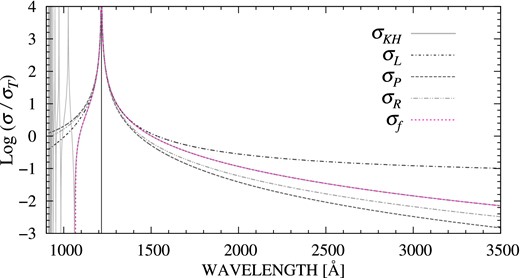
The scattering cross-section around Lyα. The Kramers–Heisenberg dispersion relation, σKH (solid line) is compared to the classical approximations, such as the Lorentzian function σL (dash–dotted), the Rayleigh scattering σR (double-dot–dashed), and the two-level approximation σP by Peebles (1993, dashed). The Lorentzian gives an excellent approximation at the line centre, but its slow damping rate causes a significant overestimation of the off-centre scattering. In the case of the Peebles approximation, resonance scattering is gently connected to the low energy scattering of the classical Rayleigh scattering (ω4 – dependence). This two-level assumption leads to a considerable underestimation of the transition probability by neglecting all possible intermediate states. The dotted line represents the cross-section (σf) based on the fitting function (see Section 2.2) that corrects the classical approximations.
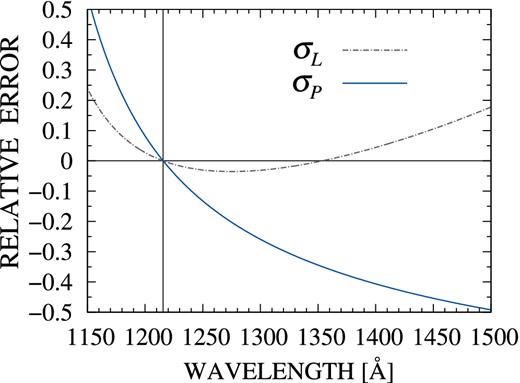
Relative errors of the classical approximations of the Lyα scattering. The relative errors (Δσ/σKH) of the Lorentzian (dash–dotted) and the Peebles approximation (solid line) have been presented. The vertical line denotes the Lyα resonance wavelength. With the extremely narrow width, the Lorentzian well approximates resonance scattering (ω → ω0). However, owing to the slow damping rate, it seriously overestimates scattering probability for low-energy photons (ω ≪ ω0). It is notable that the Lorentzian underestimates in wavelength region (λ0 < λ < 1353 Å), which may cause an asymmetry problem in identifying line profiles of the dense Lyα clouds. The largest deviation in this interval is around 3.5 per cent underestimation at λ ∼ 1274 Å. Owing to assumption of a two-level atom, the Peebles formula significantly underestimates scattering cross-section in the damping wings.
2.2 Correction function for the Lyα damping profile
In the majority of spectral line, resonance scattering is dominant, and the Lorentzian function provides an excellent approximation. However, when the number of absorbers increases, the line centre is easily saturated and radiation damping wing also becomes important. The well-constructed scattering theory of the time-dependent second-order energy perturbation already has been given (Kramers & Heisenberg 1925), but the completeness condition makes it difficult to apply to practical problems. For practical applications, we have investigated an analytic function that corrects the classical approximations. In this section, an analytic function which practically covers the whole range of the Lyα scattering is introduced.
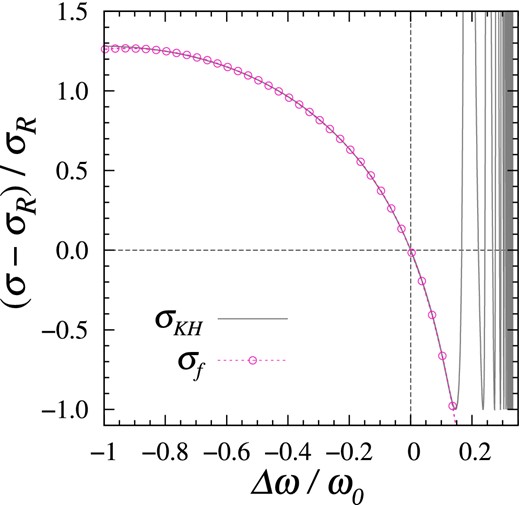
Deviation between the Rayleigh cross-section and the Kramers–Heisenberg relation. The deviation (solid) defined by equation (13) and its fitting relation (dot-circle) have been presented. The analytic function and its coefficients have been numerically determined. It is available for the wavelength region (λ ≥ 1100 Å), which practically covers radiative damping wings of the Lyα within 1 per cent error.
3 THE GP ABSORPTION PROFILES
High-resolution spectroscopy of distant quasars has revealed that various classes of clumpy Lyα absorbers are queueing along the redshift: the Lyα-forest (|$N_{\rm H\,\small {I}} \le 10^{17.2}{\rm \ cm^{-2}}$|), the LLSs (|$10^{17.2} \le N_{\rm H\,\small {I}} \le 10^{19} {\rm \ cm^{-2}}$|), and the sub-DLAs (|$10^{19} \le N_{\rm H\,\small {I}} \le 10^{20.3} {\rm \ cm^{-2}}$|) (Peroux et al. 2005; Rhee et al. 2013; Zafar et al. 2013). Especially, in case of DLAs around z ∼ 3, the column density reaches |$N_{\rm H\,\small {I}} = 2 \times 10^{20}{\rm \ cm^{-2}}$| or higher that is comparable to the typical surface density of disc galaxies (Wolfe et al. 2005). More recently, extremely strong DLAs (|$N_{\rm H\,\small {I}} \ge 0.5 \times 10^{22}{\rm \ cm^{-2}}$|) also have been detected in the redshift range (3 ≤ z ≤ 5) (Noterdaeme et al. 2014). These various Lyα clouds as vestiges of the hierarchical structure formation contain information about the physical processes and the evolutionary history of the IGM (Valageas & Silk 1999; Valageas, Silk & Schaeffer 2001). Moreover, the recent measurement of the cross-correlation between DLAs and Lyα forests from the Baryon Oscillation Spectroscopic Survey (BOSS; Font-Ribera et al. 2012) strengthens the idea that these Lyα clouds are the redshift snapshots of the gravitational evolution during structure formation. In their statistical analysis, the large-scale cross-correlation is in good agreement with linear theory of the standard Λ-CDM cosmology. Therefore, the accurate determination of column densities and redshifts is a crucial issue in probing structure formation of the early universe.
The high number of absorbers of the high-redshift Lyα systems suggest that contribution of the off–centre scattering has non-negligible effect in identifying significantly saturated damping profiles. For an accurate description of the radiation damping, a detailed computation of transition probabilities considering all possible intermediate states is required. In the previous section, the Kramers–Heisenberg dispersion formula based on the time-dependent theory in second-order energy perturbation has been introduced. Incorporating scattering theory of quantum radiation, the GP absorption profiles have been examined within the standard cosmological frames.
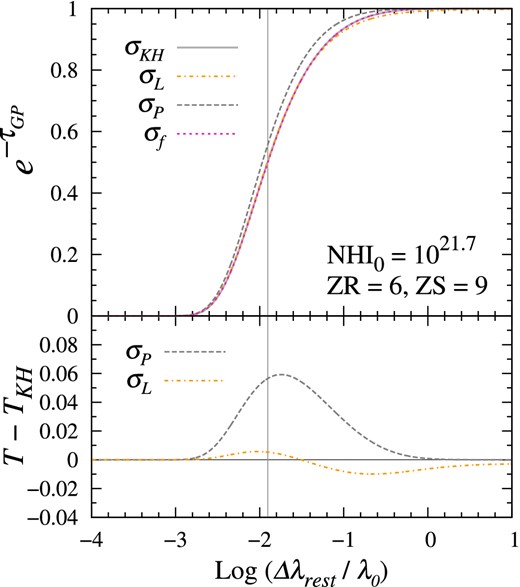
The GP absorption profiles and relative errors of the classical approximations. With the neutral hydrogen column density |$N_{{\rm H\,\small {I}}\;\!0}$| = 5 × 1021 cm−2 and the redshift interval (zr, zs) = (6, 9), the GP fractional transmission, |$T \equiv {\rm e}^{-\tau _{{\rm GP}}}$| (top) and their differences ΔT = T − TKH (bottom) are illustrated in rest-wavelength. (σKH, σL, σP, σf) denotes the Kramers–Heisenberg relation (solid), the Lorentzian function (dash–dotted), the two-level approximation by Peebles (1993), and the fitting function (red dotted), respectively. It is notable that the σP results in around 11 per cent overestimation of transmitted flux. Owing to the asymptotic behaviours, the Lorentzian cannot resolve the cumulative effects by a train of clumpy absorbers in the line of sight.
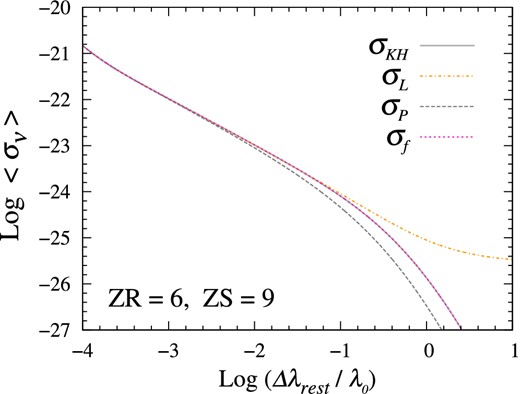
Comoving mean absorption coefficients of the uniformly distributed IGM.
For a highly saturated absorption profile, the line width of the broad damping wing is an important measurable quantity. Especially, the complete GP troughs are characterized by only one red damping wing, so that the effective line width can be identified with the HWHM (≡Δλrest). Under the same cosmological configurations, we compare various approximation schemes for the Lyα scattering cross-section by adjusting the characteristic number density. In Fig. 6, the theoretical HWHM of the absorption line (top) and the relative errors of the classical approximations (bottom) are presented. For a column density with |$\log N_{{\rm H\,\small {I}}\;\!0}< 20$|, the classical approximations are in good agreement (within 1 per cent error). However, as the number of absorbers increases, the Peebles approximation estimates a narrower HWHM than the intrinsic one. In the case of higher column densities (|$\log N_{{\rm H\,\small {I}}\;\!0}= 21$|) where the intrinsic HWHM (Δλrest) = 3.07 Å, the Peebles approximation results in 5 per cent narrower width with the value of HWHM (Δλrest) = 2.92 Å. When the column density reaches |$\log N_{{\rm H\,\small {I}}\;\!0}= 22$|, the Peebles approximation yields a half-width that is smaller by 20 per cent. On the other hand, the Lorentzian model well approximates the intrinsic HWHM within 1 per cent of error until the column density of |$\log N_{{\rm H\,\small {I}}\;\!0}= 22$|, but it deviates steeply for higher densities. As Miralda-Escudé (1998) discussed, there is a degeneracy problem in determining density and redshift in the presence of absorption systems. Moreover, the evolved IGM seems to be distributed inhomogeneously near the end of reionization epoch. Therefore, an accurate cross-section scheme can invoke the accurate determination of the line centre and the column density distribution.
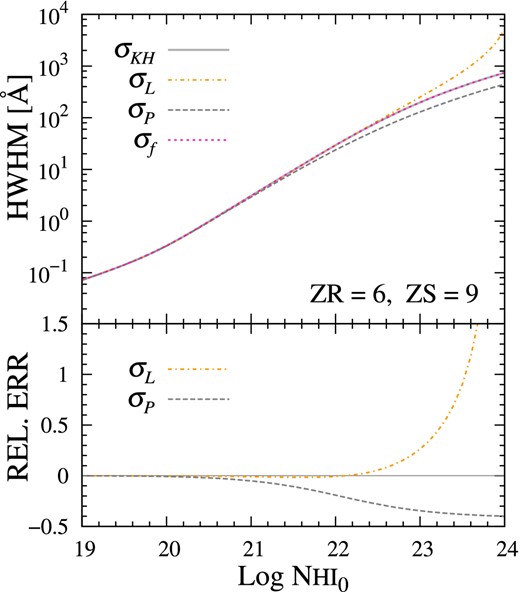
The line width of the GP troughs. Owing to one broad red wing, the complete GP troughs can be evaluated by the HWHM (half-width at half-maximum). For each cross-section scheme, the HWHM (top) and their relative errors (bottom) have been illustrated. When the neutral column density reaches |$N_{{\rm H\,\small {I}}\;\!0}\sim 10^{21} {\rm \ cm^{-2}}$|, the Peebles approximation results in 5 per cent underestimation of the half line width. Until |$N_{{\rm H\,\small {I}}\;\!0}\sim 10^{22} {\rm \ cm^{-2}}$|, the Lorentzian provides a good approximation within 1 per cent errors. For a higher column density, it deviates steeply.
Due to the high line strength of the Lyα transition, the GP absorption profiles are seriously saturated. Consequently, the GP test is sensitive at the end of the reionization where the IGM is mostly ionized (Fan et al. 2006a). However, well-defined damping profiles can give a better interpretation of the shape and width of the GP absorption. Considering a reliable scattering theory, our model of the GP trough provides a better understanding of the epoch of cosmic reionization.

The GP transmission. Considering the Kramers–Heisenberg cross-section (σKH) and recent cosmological parameters (|$\Omega _\Lambda$|, ΩM, h) = (0.72, 0.23, 0.71), the theoretical absorption profiles have been calculated. By adjusting the redshift of the source (top) and the column number density (bottom), a set of the GP absorption profiles has been calculated.
Physical parameters in the GP model grids. The characteristic column number density of atomic hydrogen |$N_{{\rm H\,\small {I}}\;\!0}$|, the comoving number density n0, the characteristic GP optical depth τ0, and the red HWHM (Δλ) in the rest frame are presented.
| zs . | |$\log N_{{\rm H\,\small {I}}\;\!0}$| . | n0 . | τ0 . | HWHM (Å) . |
|---|---|---|---|---|
| 8 | 21.30 | 1.55 × 10−7 | 4.64 × 105 | 5.210 |
| 10 | 21.30 | 1.55 × 10−7 | 6.27 × 105 | 7.061 |
| 12 | 21.30 | 1.55 × 10−7 | 8.06 × 105 | 9.065 |
| 14 | 21.30 | 1.55 × 10−7 | 9.99 × 105 | 11.213 |
| 9 | 20.30 | 1.55 × 10−8 | 5.43 × 104 | 0.618 |
| 20.80 | 4.91 × 10−8 | 1.72 × 105 | 1.941 | |
| 21.30 | 1.55 × 10−7 | 5.43 × 105 | 6.116 | |
| 21.80 | 4.91 × 10−7 | 1.72 × 106 | 18.931 | |
| 22.30 | 1.55 × 10−6 | 5.43 × 106 | 55.174 |
| zs . | |$\log N_{{\rm H\,\small {I}}\;\!0}$| . | n0 . | τ0 . | HWHM (Å) . |
|---|---|---|---|---|
| 8 | 21.30 | 1.55 × 10−7 | 4.64 × 105 | 5.210 |
| 10 | 21.30 | 1.55 × 10−7 | 6.27 × 105 | 7.061 |
| 12 | 21.30 | 1.55 × 10−7 | 8.06 × 105 | 9.065 |
| 14 | 21.30 | 1.55 × 10−7 | 9.99 × 105 | 11.213 |
| 9 | 20.30 | 1.55 × 10−8 | 5.43 × 104 | 0.618 |
| 20.80 | 4.91 × 10−8 | 1.72 × 105 | 1.941 | |
| 21.30 | 1.55 × 10−7 | 5.43 × 105 | 6.116 | |
| 21.80 | 4.91 × 10−7 | 1.72 × 106 | 18.931 | |
| 22.30 | 1.55 × 10−6 | 5.43 × 106 | 55.174 |
Physical parameters in the GP model grids. The characteristic column number density of atomic hydrogen |$N_{{\rm H\,\small {I}}\;\!0}$|, the comoving number density n0, the characteristic GP optical depth τ0, and the red HWHM (Δλ) in the rest frame are presented.
| zs . | |$\log N_{{\rm H\,\small {I}}\;\!0}$| . | n0 . | τ0 . | HWHM (Å) . |
|---|---|---|---|---|
| 8 | 21.30 | 1.55 × 10−7 | 4.64 × 105 | 5.210 |
| 10 | 21.30 | 1.55 × 10−7 | 6.27 × 105 | 7.061 |
| 12 | 21.30 | 1.55 × 10−7 | 8.06 × 105 | 9.065 |
| 14 | 21.30 | 1.55 × 10−7 | 9.99 × 105 | 11.213 |
| 9 | 20.30 | 1.55 × 10−8 | 5.43 × 104 | 0.618 |
| 20.80 | 4.91 × 10−8 | 1.72 × 105 | 1.941 | |
| 21.30 | 1.55 × 10−7 | 5.43 × 105 | 6.116 | |
| 21.80 | 4.91 × 10−7 | 1.72 × 106 | 18.931 | |
| 22.30 | 1.55 × 10−6 | 5.43 × 106 | 55.174 |
| zs . | |$\log N_{{\rm H\,\small {I}}\;\!0}$| . | n0 . | τ0 . | HWHM (Å) . |
|---|---|---|---|---|
| 8 | 21.30 | 1.55 × 10−7 | 4.64 × 105 | 5.210 |
| 10 | 21.30 | 1.55 × 10−7 | 6.27 × 105 | 7.061 |
| 12 | 21.30 | 1.55 × 10−7 | 8.06 × 105 | 9.065 |
| 14 | 21.30 | 1.55 × 10−7 | 9.99 × 105 | 11.213 |
| 9 | 20.30 | 1.55 × 10−8 | 5.43 × 104 | 0.618 |
| 20.80 | 4.91 × 10−8 | 1.72 × 105 | 1.941 | |
| 21.30 | 1.55 × 10−7 | 5.43 × 105 | 6.116 | |
| 21.80 | 4.91 × 10−7 | 1.72 × 106 | 18.931 | |
| 22.30 | 1.55 × 10−6 | 5.43 × 106 | 55.174 |
4 SUMMARY AND DISCUSSION
The highest redshift Lyα systems are crucial evidence of the small-scale evolution of the IGM. The GP test provides a firm diagnosis of neutrality of baryonic matter during the late phase of cosmic reionization. The ultimate goal of this paper is to provide a reliable constraint of the GP absorption profiles adopting quantum theory of radiation. Considering all possible intermediate transitions, our derivation of the Kramers–Heisenberg dispersion relation has been compared with the classical approximations such as the Rayleigh scattering, the Lorentzian function, and the two-level approximation by Peebles (1993). Near the line centre, the Lorentzian provides a good approximation for optically thin medium where the resonance scattering is still dominant. In the case of high column density systems, however, off-centre scattering also becomes important, and the broad damping wing is a distinguishable measurement in high-resolution spectroscopy. Especially, when the column density reaches |$N_{\rm H\,\small {I}} = 10^{22} {\rm \ cm^{-2}}$|, the GP models based on the classical scattering theories cannot give a proper estimation of the transmitted flux and the line width. Therefore, a detailed cross-section theory is considered in identifying highly saturated absorption lines.
In practice, the pure damped absorption profile cannot be directly detected without accompanying Lyα absorption systems that reside along the line of sight. In order to determine the intrinsic absorption profiles of the damped absorption systems, a superposed absorption by Lyα clouds should be subtracted from them. In principle, the large-scale correlations of DLAs and Lyα forests are accurately predicted by linear theory of the standard Λ-CDM cosmology. Especially, recent statistical analysis of BOSS data (Font-Ribera et al. 2012) has successfully measured the cross-correlation between DLAs and Lyα forests. From similarity of the Lyα clouds on large scale, the intrinsic damped profiles can be elicited.
Recent observations detected extremely strong DLAs (|$N_{\rm H\,\small {I}} \ge 0.5 \times 10^{22}{\rm \ cm^{-2}}$|) in the redshift range 3 ≤ z ≤ 5 (Noterdaeme et al. 2014). The spectra of the highest redshift quasars indicate that the Lyα optical depth increases with τ ∝ (1 + z)4.3 until z < 5.5 (Fan et al. 2006a). Following the growth of the neutral fraction of hydrogen (≥0.1), the optical depth rapidly increases τ ∝ (1 + z)10 around the end of the reionization epoch (z > 5.5) (Fan 2012). Since the IGM evolves dramatically during cosmic reionization, a more realistic model of density distribution has been considered in the GP model (Mesinger & Haiman 2004; Bolton & Haehnelt 2007). Specifically, the transmitted flux of a recently detected quasar (z ∼ 7.1) exhibits a qualitatively different shape and width from the simple GP absorption profiles (Mortlock et al. 2011). As discussed in their work, this discrepancy seems to be affected by inhomogeneity of neutral medium, or by a complex geometry of IFs of the Strömgren sphere. If the Lyα emitters are embedded in a mostly neutral region, the GP absorption profile will give a substantial information of the density distribution near the ionizing fronts. However, with the Lyα absorption, it is not easy to interpret the cumulative effect of the intervening |${{\rm H}\,\small {ii}}$| bubbles which may exist along the line of sight. During the last decade, the size distribution of the ionized bubbles and the corresponding 21 cm signal have been studied by theoretical models (Furlanetto, Zaldarriaga & Hernquist 2004; Iliev et al. 2006; McQuinn et al. 2006; Trac & Cen 2007; Wyithe & Loeb 2007; Choudhury, Haehnelt & Regan 2009). Future observations of the 21 cm line will provide deeper understanding of the density distribution and the reionization processes.
In general, the observed spectrum is affected by the density, temperature, and velocity of the gas located along the line of sight. The Voigt function has been successfully applied to high redshift absorption systems with a wide range of H i column densities. At column density smaller than |$N_{{\rm H\,\small {I}}}\sim 10^{22} {\rm \ cm^{-2}}$|, the Lorentzian function as natural line broadening can be marginally applicable within 1 per cent error. In order to describe line asymmetry of the Lyα forest spectra, Outram, Carswell & Theuns (2000) suggested a statistical method to detect departure from the Voigt profile using non-Gaussian velocity distributions. For denser systems, a detailed treatment of radiation damping also should be included in the Voigt fitting.
We thank the anonymous referee for the constructive suggestions and comments. We are grateful to Roger Blandford, Evangelia Tremou, and Camilla Pacifici for invaluable suggestions and discussions. This research was supported by the Basic Science Research Programme through the National Research Foundation of Korea (NRF) funded by the Ministry of Education, Science and Technology (NRF-2010-0024990). KB gratefully acknowledges financial support by the Basic Science Research Programme (NRF-2014-11-1019) and the BK 21 Plus Research Programme (21A-2013-15-00002).



